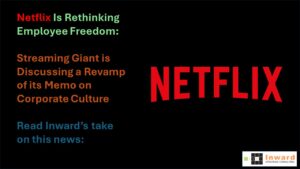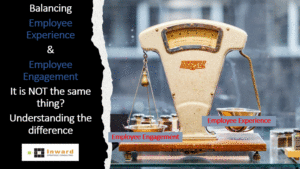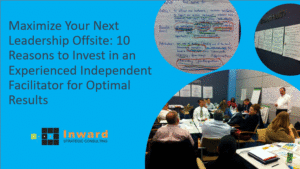Symptoms of a Broken Organizational Culture: An Inward Strategic Consulting Perspective
In this technologically driven era, the symptoms of a broken organizational culture are often obviously apparent. Stalled tasks, deteriorating worker morale, and negative remarks by the customers serve as stark indicators of underlying trouble. When an employer’s tradition is fractured, it has a profound impact on its potential to function effectively and achieve its goals. Recognizing these signs is crucial for leaders to deal with the root reasons and steer the employer towards a more productive lifestyle.
At Inward Strategic Consulting, we apprehend the importance of a strong organizational culture and defining a company’s cause. We recognize that culture and reason are not merely buzzwords or superficial attributes. It’s a dynamic pressure that affects how employees engage, make decisions, and ultimately contribute to the success of the organization. To tackle culture/purpose-related issues, leaders often turn to numerous tasks and events aimed toward reinforcing or transforming culture. However, these efforts often fall short. It is because of their reactionary nature and shortage of comprehensive approaches.
In a world where change is constant, businesses are under consistent pressure to adapt. Whether it’s embracing new technology, or responding to shifting consumer expectations, organizations frequently turn to culture-building as a means to inspire employees and align them with the purpose of the agency. Unfortunately, research has shown that the majority of transformation efforts fail, with culture-related problems being a prominent factor in these failures. According to McKinsey, a staggering 70% of alterations are unsuccessful, and 70% of those failures can be attributed to culturally demanding situations. Michael Hammer, the father of the Reengineering Movement shared this fact with me over 25 years ago as well. Back then, the numbers were in the 80% range. It was one of the primary reasons we launched our firm.
Gallup, a leading research and consulting organization, has shed light on the state of corporate lifestyle in the United States. Their surveys reveal a disheartening truth: only two out of every ten personnel feel deeply connected to their enterprise’s culture. This disconnect can have profound results, impacting engagement, innovation, and overall business performance.
To cope with those demanding situations, leaders want to adopt a proactive and strategic approach to culture transformation. This is where Inward Strategic Consulting steps in, offering a roadmap to drive effective culture change.
Driving Culture Transformation: The Four-Step Approach
- Sustain Your Ecosystem: Culture is a living entity that requires ongoing nurturing. To sustain culture change, organizations need systems, structures, and rituals that uphold positive behaviors. Policies should support culture, not hinder it, and managers play a pivotal role in guiding employees through the cultural landscape.
Building a culture-sustaining ecosystem involves aligning systems and processes, using storytelling to reinforce behaviors, and investing in manager education. By consistently measuring progress, organizations can ensure that culture remains vibrant and adaptive.
For instance, we often cite Subaru for establishing its brand purpose and culture around “Love”. Subaru’s brand culture is indeed a unique and distinctive aspect of the company’s identity. This emphasis on love reflects Subaru’s commitment to its customers, communities, and the environment. The “LOVE” concept encompasses several key facets of the business and target audiences and social welfare.
Overall, Subaru’s focus on “LOVE” as a central tenet of its brand culture goes beyond just selling cars. It aims to create a holistic experience that resonates with the customers’ and employees’ emotions and values. This approach has helped Subaru cultivate a unique and loyal customer base that identifies with the brand’s commitment to love, community, and responsible business practices.Top of Form
- Align Your Workforce: For culture to take hold, it must be deeply ingrained in the fabric of the organization. This requires aligning individual goals with the company’s purpose, vision, and values. Gallup’s research shows that a mere 20% of individual contributors feel connected to the organization’s culture. To bridge this gap, leaders must define values in actionable terms and clearly communicate what these values mean.
Effective alignment involves embedding culture into every stage of the employee experience, from recruitment to development. By explicitly connecting culture to the organization’s strategy, employees can see how their individual contributions shape the bigger picture.
- Drive Adoption: A strong culture doesn’t require coercion; it inspires and engages employees organically. To drive adoption, leaders must move beyond superficial gestures like posters and parties. Instead, they should demonstrate the organization’s commitment to culture through actions that link it to the company’s mission and brand. Behavioral changes, processes, and systems should all reflect the desired culture.
Take the instance of the outdoor store Patagonia, which exemplifies a tradition of flexibility through regulations that inspire employees to pursue personal passions. However, culture cannot be copied; it needs to be integrated in a manner that resonates with the corporation’s precise context.
- Define (or Redefine) Your Culture and Purpose: Culture is a multifaceted concept. It cannot be explained via a single definition. However, at its core, culture reflects “how we do matters around here and why.” To effectively transform culture, leaders ought to understand the prevailing tradition and identify its strengths and weaknesses. This includes conducting interviews, surveys, and focus groups to gain insights into the agency’s cultural DNA.
Gallup’s experience with a large professional services firm illustrates the complexity of culture. While collaboration was a strong point, it inadvertently led to challenges such as slowed decision-making and increased risk aversion. By examining these nuances, leaders can identify behaviors that need refinement and alignment with the organization’s aspirational culture.
Embracing Culture Change for Success:
In the realm of organizational culture, leaders must take ownership. Without clear accountability, culture-building efforts can easily falter, leaving the organization adrift. As Edgar Schein aptly puts it, managing culture is of paramount importance for leaders. If not managed, culture can inadvertently dictate the course of the organization.
Inward Strategic Consulting advocates for a coordinated approach to culture transformation. The benefits of a well-crafted culture are immense, including heightened engagement, employee loyalty, and profitability. By following the four steps outlined above, leaders can revitalize their organization’s culture and harness its power for lasting success.
The journey in the direction of a thriving tradition begins with a deep understanding of the existing state, aligning the workforce with a shared vision, fostering adoption through significant actions, and sustaining the ecosystem that nurtures the culture’s growth. At Inward Strategic Consulting, we accept that a strong organizational culture isn’t just an aspiration—it’s a strategic imperative.

































